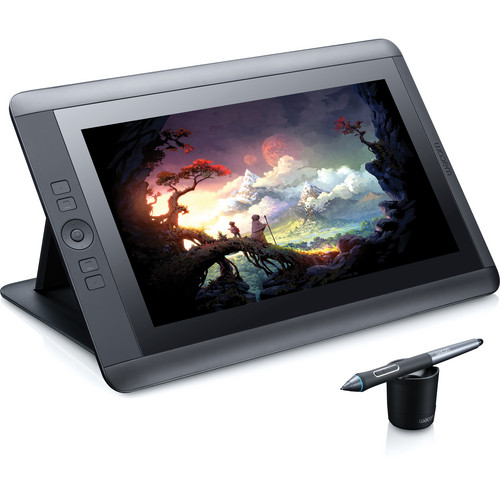
Cintiq 13HD 13.3" Interactive Pen Display
For the past month I’ve been using a Cintiq 13HD 13.3" Interactive Pen Display. Previously I had been using the Wacom Intuos 4, and I was a Intuos 3 user before that.
Like many, I was excited about the idea of having a display built into the tablet because I thought it would be great for editing images. It seemed like a brilliant idea, so I was excited when my review unit arrived.
During my testing I tried it both with a MacBook Pro (pre-ThunderBolt) and my Windows 7 based Alienware Aurora systems. I started off by doing a calibration as the default picture quality on the display was terrible.
Overall I found the setup and ease of use on the Mac to be very good. Things just worked for the most part, but on Windows the drivers didn’t seem to be very good. Despite downloading the latest driver off the web, my Drobo Pro connected via iSCSI stopped working when I installed the tablet driver. Over a month later I haven’t been able to figure out what it did, so I’ve had to resort to using my Drobo in the very slow USB mode.
I eventually got it working on my PC, but it certainly was less stable than my Intuos 4 (in USB mode).
Overall Impressions
It’s times like this that I’m glad that I can review products because this is one that I found to be very disappointing. Perhaps it is because I use a Asus Zenbook with a touch screen as my daily work laptop, but I found the display both lacking in color depth and the touch performance to be mediocre. The pictures always show vivid images, but the viewing angle of this device isn’t very good so you have to be looking at it fairly head on to get the best picture quality.
Another practical oddity that you never think about until you own one these is that you can’t just drag your pen to objects on your other displays. You must first tap a display toggle button, otherwise your pen is locked to the Cintiq or your other displays. While this logically makes sense, in practice I found it hard to get used to.
Ironically I found that I didn’t really like running Photoshop on the Cintq because on the Mac the toolbar would default to the non Citique display so I kept having to toggle back and forth between displays to use the menu. While I could move the Mac’s menu to the Cintiq, that isn’t where I wanted it for all of my other apps.
Windows applications are self contained so they worked much better with the Cintq, but the tiny display was too small to host all of Photoshop. As a result, I found myself leaving the main app on one display and dragging just the window to the Cintq. This lead me with the Mac problem where I had to toggle to switch my cursor back and forth between the Citniq and my other displays. This was too cumbersome and annoying.
Perhaps the most shocking discovery was that for precise photo editing, the small display was challenging to use and my hands kept getting in the way. Sure, I could do nice demos of how things work but in practice I hated editing photos directly on the Citniq display. This lead me to use the Cintiq as a regular tablet, rather than something I can edit with.
Conclusion
Due to the previously obscene prices of the Cintiq’s, I never bothered to buy one and I couldn’t get one to review. After being used to Retina iPad’s, iPhone’s, and Windows 8 touch devices my bar about what I expect from a color display and touch screen is high. The Cintiq display failed to meet those expectations. It felt a bit like an outdated display with only pen technology to control it when my fingers were expecting to be able to do both touch and pen (like a Samsung Note or Windows Surface Pro).
I’m sure there will be fan boys who scream bloody murder at my review, and there’s probably sketch artist who will appreciate the Cintiq’s more than me. However, I ended up either not using it, or using it only as a tablet during a portion of my review period.
My advice is to save your money and get a Wacom Intuos 5. You’ll get pen performance that is roughly the same as the Cintiq, but you’ll have money to buy a good display like the NEC PA Series. This is basically what I’m doing now, but I anxiously await the near future when all my displays have capacitive touch support so the Cintiq won’t make any sense. Even today, a device like the Lenovo ThinkPad Helix gives you a touch display that is better than a Cintiq with a tablet & laptop included for only a few hundred dollars more.
Where to order
Click here to order the Cintiq 13HD 13.3" Interactive Pen Display at B&H web site, or go for the Wacom Intuos 5 instead.
Other articles you may enjoy
If you enjoyed this article, you may also enjoy these:
- Wacom Intuos 4 Review
- Choosing The Right Display Calibration Device
- NEC PA Series Monitors
- NEC PA242W
Disclosure
If you make a purchase using links found in this article, I may make a commission. It doesn’t cost you a penny more, but it does help to support future articles like this.
I was provided with a loaner tablet which I returned after publishing this article.

